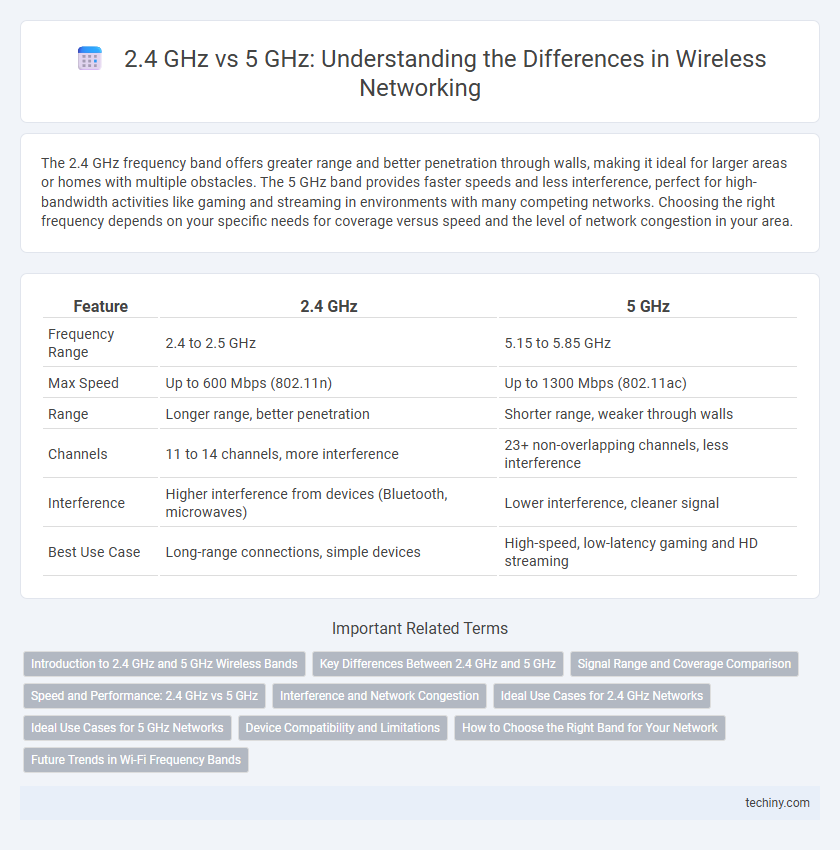The 2.4 GHz frequency band offers greater range and better penetration through walls, making it ideal for larger areas or homes with multiple obstacles. The 5 GHz band provides faster speeds and less interference, perfect for high-bandwidth activities like gaming and streaming in environments with many competing networks. Choosing the right frequency depends on your specific needs for coverage versus speed and the level of network congestion in your area.
Table of Comparison
| Feature | 2.4 GHz | 5 GHz |
|---|---|---|
| Frequency Range | 2.4 to 2.5 GHz | 5.15 to 5.85 GHz |
| Max Speed | Up to 600 Mbps (802.11n) | Up to 1300 Mbps (802.11ac) |
| Range | Longer range, better penetration | Shorter range, weaker through walls |
| Channels | 11 to 14 channels, more interference | 23+ non-overlapping channels, less interference |
| Interference | Higher interference from devices (Bluetooth, microwaves) | Lower interference, cleaner signal |
| Best Use Case | Long-range connections, simple devices | High-speed, low-latency gaming and HD streaming |
Introduction to 2.4 GHz and 5 GHz Wireless Bands
The 2.4 GHz wireless band operates on lower frequencies, offering broader coverage and better penetration through walls, making it ideal for larger areas with obstacles. The 5 GHz band provides higher data rates and reduced interference due to its wider channels and less congested spectrum, suitable for high-bandwidth applications in close proximity to the router. Understanding the strengths and limitations of both bands enables optimized wireless network performance for various environments.
Key Differences Between 2.4 GHz and 5 GHz
The 2.4 GHz frequency band offers broader coverage and better penetration through walls but suffers from more interference due to overcrowding from devices like microwaves and Bluetooth gadgets. In contrast, the 5 GHz band provides faster data rates and less congestion, ideal for high-bandwidth activities, but has a shorter range and weaker obstacle penetration. Devices operating on 5 GHz typically experience lower latency and higher throughput, making it optimal for gaming and streaming applications.
Signal Range and Coverage Comparison
The 2.4 GHz band offers broader signal range and better penetration through walls and obstacles, making it ideal for larger areas and multi-story homes. In contrast, the 5 GHz band provides faster data rates but has a shorter range and is more easily attenuated by physical barriers. Choosing between 2.4 GHz and 5 GHz depends on whether greater coverage or higher speed is the priority for a particular networking environment.
Speed and Performance: 2.4 GHz vs 5 GHz
The 5 GHz band offers significantly higher speeds and less interference compared to 2.4 GHz due to its wider channels and reduced congestion. While 2.4 GHz provides better range and penetration through walls, its lower bandwidth limits maximum throughput, making it suitable for basic browsing and IoT devices. For performance-intensive tasks like gaming, 4K streaming, and large file transfers, the 5 GHz band delivers superior speed and low-latency connectivity.
Interference and Network Congestion
The 2.4 GHz band is more prone to interference and network congestion due to its longer range and common use in household devices like microwaves, Bluetooth devices, and cordless phones, leading to signal overlap and slower connection speeds. In contrast, the 5 GHz band offers less interference and reduced congestion because it has more non-overlapping channels and is less crowded, which enhances overall network performance and stability. For environments with multiple networks or heavy device usage, 5 GHz is preferable to minimize connection drops and ensure faster data transfer rates.
Ideal Use Cases for 2.4 GHz Networks
2.4 GHz networks excel in providing broader coverage and better penetration through walls, making them ideal for larger homes or areas with many obstacles. Their longer range supports devices that require consistent connectivity over extended distances, such as smart home sensors and devices in distant rooms. Due to lower channel congestion compared to 5 GHz in some environments, 2.4 GHz is better suited for basic internet browsing and email on legacy devices.
Ideal Use Cases for 5 GHz Networks
5 GHz networks offer faster data transfer speeds and lower interference compared to 2.4 GHz, making them ideal for high-bandwidth activities such as HD video streaming, online gaming, and large file transfers. Environments with many competing Wi-Fi signals benefit from 5 GHz's wider channel availability and reduced congestion. Devices positioned close to the router achieve optimal connectivity and performance on 5 GHz frequencies.
Device Compatibility and Limitations
2.4 GHz Wi-Fi offers broader device compatibility with most older and low-power devices due to its longer range and better penetration through obstacles, but it suffers from higher interference and lower data speeds. The 5 GHz band provides faster speeds and reduced interference but has a shorter range and is less compatible with legacy devices. Users must consider their device ecosystem and coverage needs when choosing between these frequency bands for optimal connectivity.
How to Choose the Right Band for Your Network
Choosing the right band for your network involves understanding the range and speed requirements of your devices. The 2.4 GHz band offers better range and penetration through walls but supports slower speeds and is more prone to interference from other electronics. The 5 GHz band delivers faster data rates and less interference, making it ideal for high-bandwidth applications like streaming and gaming, but with a shorter effective range.
Future Trends in Wi-Fi Frequency Bands
The evolution of Wi-Fi frequency bands highlights a growing shift from 2.4 GHz to 5 GHz and beyond, driven by the increasing demand for faster speeds and reduced interference. Future trends emphasize the adoption of 6 GHz and upcoming 7 GHz bands, which offer enhanced bandwidth and lower latency for advanced applications such as 4K streaming and IoT connectivity. Innovations in Wi-Fi 6E and Wi-Fi 7 standards will further optimize network performance by exploiting these higher frequency bands while maintaining backward compatibility with existing devices.
2.4 GHz vs 5 GHz Infographic

 techiny.com
techiny.com